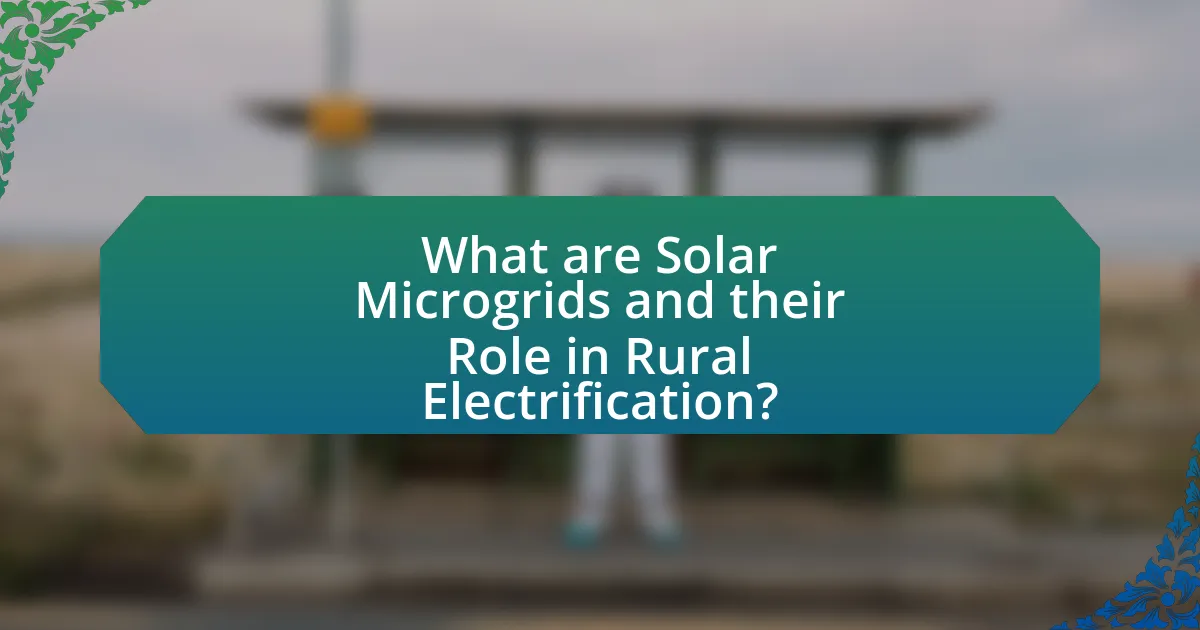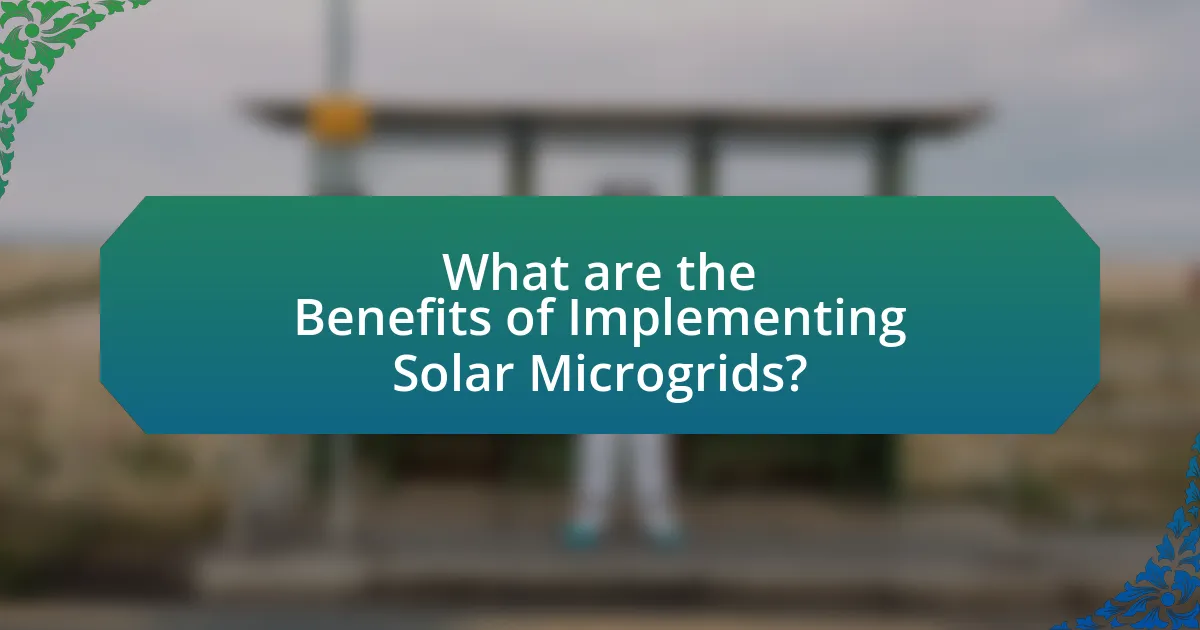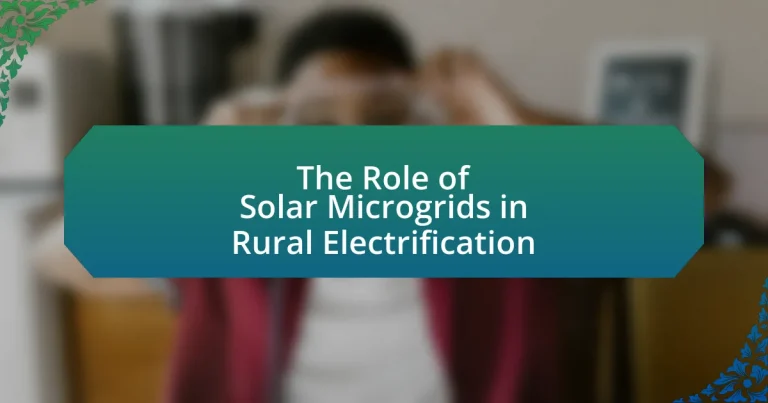Solar microgrids are localized energy systems that utilize solar power to generate and distribute electricity, particularly in rural areas lacking access to centralized power infrastructure. They provide reliable and sustainable energy solutions, significantly reducing energy costs and enhancing energy security for remote communities. The article explores the functioning of solar microgrids, their key components, and their integration with existing energy systems, while highlighting their importance for rural electrification, economic development, and environmental sustainability. Additionally, it addresses the challenges and limitations faced in implementing solar microgrids, including financial barriers and technical complexities, and outlines best practices for successful deployment and community involvement.

What are Solar Microgrids and their Role in Rural Electrification?
Solar microgrids are localized energy systems that generate and distribute electricity using solar power, often operating independently from the main grid. They play a crucial role in rural electrification by providing reliable and sustainable energy access to remote communities that lack connection to centralized power infrastructure. According to the International Renewable Energy Agency (IRENA), solar microgrids can significantly reduce energy costs and improve energy security, enabling rural areas to harness renewable resources effectively. In regions where traditional grid expansion is economically unfeasible, solar microgrids offer a viable solution, enhancing the quality of life and supporting local economic development through increased access to electricity for homes, schools, and businesses.
How do Solar Microgrids function in rural areas?
Solar microgrids function in rural areas by providing localized energy generation and distribution, primarily through solar panels and battery storage systems. These systems operate independently from the main grid, allowing rural communities to harness solar energy for electricity needs. For instance, a solar microgrid can generate power during the day, store excess energy in batteries, and supply electricity during nighttime or cloudy days, ensuring a reliable energy source. According to the International Renewable Energy Agency (IRENA), solar microgrids can reduce energy costs by up to 50% compared to traditional diesel generators, making them a cost-effective solution for rural electrification.
What are the key components of a Solar Microgrid?
The key components of a Solar Microgrid include solar panels, energy storage systems, inverters, control systems, and distribution infrastructure. Solar panels convert sunlight into electricity, while energy storage systems, such as batteries, store excess energy for use during low sunlight periods. Inverters are crucial for converting direct current (DC) generated by solar panels into alternating current (AC) for use in homes and businesses. Control systems manage the flow of electricity, ensuring stability and efficiency within the microgrid. Finally, distribution infrastructure, including wiring and transformers, delivers electricity to end-users. These components work together to create a self-sufficient energy system, particularly beneficial for rural electrification, where traditional grid access may be limited.
How do Solar Microgrids integrate with existing energy systems?
Solar microgrids integrate with existing energy systems by functioning as localized energy networks that can operate independently or in conjunction with the main grid. They achieve this integration through advanced control systems that manage energy generation, storage, and consumption, allowing for seamless transitions between grid-connected and off-grid modes. For instance, during peak demand periods, solar microgrids can supply excess energy back to the main grid, enhancing overall grid stability and reliability. Additionally, they utilize smart technology to optimize energy distribution and ensure that renewable sources, such as solar panels, are effectively harnessed, thereby reducing reliance on fossil fuels and contributing to a more sustainable energy landscape.
Why are Solar Microgrids important for rural communities?
Solar microgrids are crucial for rural communities because they provide reliable and sustainable energy access, which is often lacking in these areas. By utilizing renewable solar energy, microgrids can operate independently from the central grid, ensuring that rural populations have a consistent power supply. According to the International Renewable Energy Agency (IRENA), over 1 billion people globally lack access to electricity, with a significant portion residing in rural regions. Solar microgrids can reduce this energy gap by enabling local energy generation, which not only supports basic needs like lighting and cooking but also fosters economic development through improved access to education, healthcare, and technology.
What challenges do rural areas face in terms of electrification?
Rural areas face significant challenges in terms of electrification, primarily due to limited infrastructure, high costs, and geographical isolation. The lack of existing power grids makes it difficult to extend electricity services, as building new infrastructure can be prohibitively expensive. According to the International Energy Agency, approximately 789 million people globally lack access to electricity, with a substantial portion residing in rural regions where population density is low, making traditional grid expansion economically unfeasible. Additionally, the remoteness of these areas complicates maintenance and repair efforts, leading to unreliable service. These factors collectively hinder the progress of electrification initiatives in rural communities.
How do Solar Microgrids address these challenges?
Solar microgrids address challenges in rural electrification by providing localized, reliable energy solutions that enhance energy access and resilience. They enable communities to generate and manage their own electricity, reducing dependence on centralized power systems that may be unreliable or non-existent. For instance, solar microgrids can operate independently from the main grid, ensuring continuous power supply even during outages. Additionally, they can be tailored to meet specific local energy needs, which is crucial in areas with limited infrastructure. Studies have shown that implementing solar microgrids can lead to a 30% increase in energy access in rural regions, demonstrating their effectiveness in overcoming electrification barriers.

What are the Benefits of Implementing Solar Microgrids?
Implementing solar microgrids offers numerous benefits, including enhanced energy access, increased reliability, and reduced greenhouse gas emissions. Solar microgrids provide localized energy solutions, particularly in rural areas where traditional grid infrastructure is lacking or unreliable, thus improving energy access for communities. According to the International Renewable Energy Agency (IRENA), solar microgrids can reduce energy costs by up to 50% compared to diesel generators, making them a cost-effective alternative. Additionally, solar microgrids enhance energy reliability by providing a stable power supply, which is crucial for economic development and improving quality of life. Furthermore, they contribute to environmental sustainability by utilizing renewable energy sources, thereby decreasing reliance on fossil fuels and lowering carbon emissions.
How do Solar Microgrids enhance energy access?
Solar microgrids enhance energy access by providing localized, renewable energy solutions that can operate independently from the central grid. These systems enable communities, particularly in rural areas, to generate and distribute electricity using solar power, which is abundant and sustainable. According to the International Renewable Energy Agency (IRENA), solar microgrids can significantly reduce energy costs and improve reliability, as they are less susceptible to outages compared to traditional grid systems. Furthermore, a study by the World Bank indicates that solar microgrids can increase electricity access for over 1 billion people globally, thereby fostering economic development and improving quality of life in underserved regions.
What impact do Solar Microgrids have on local economies?
Solar microgrids significantly enhance local economies by providing reliable electricity, which fosters business development and job creation. Access to consistent power enables local entrepreneurs to operate businesses more efficiently, leading to increased economic activity. For instance, a study by the International Renewable Energy Agency (IRENA) found that rural electrification through solar microgrids can boost local GDP by up to 10% in some regions. Additionally, solar microgrids reduce energy costs for households and businesses, allowing for reinvestment in local economies. This economic uplift is further supported by the creation of new jobs in installation, maintenance, and operation of microgrid systems, contributing to sustainable economic growth.
How do they contribute to environmental sustainability?
Solar microgrids contribute to environmental sustainability by providing clean, renewable energy that reduces reliance on fossil fuels. By harnessing solar power, these systems lower greenhouse gas emissions, which are a major contributor to climate change. For instance, a study by the International Renewable Energy Agency (IRENA) found that solar energy can reduce carbon dioxide emissions by up to 90% compared to traditional energy sources. Additionally, solar microgrids promote energy independence in rural areas, decreasing the environmental impact associated with energy transportation and distribution. This localized energy generation minimizes transmission losses and enhances the resilience of energy systems in remote communities.
What are the social implications of Solar Microgrids?
Solar microgrids significantly enhance social equity and community resilience in rural areas. By providing reliable and affordable electricity, they empower local populations, improve access to education and healthcare, and stimulate economic activities. For instance, a study by the International Renewable Energy Agency (IRENA) found that solar microgrids can increase school attendance by up to 30% due to improved lighting for evening study. Additionally, these systems foster community engagement and collaboration, as local stakeholders often participate in their development and management, leading to stronger social ties and shared responsibility.
How do Solar Microgrids improve quality of life in rural areas?
Solar microgrids improve quality of life in rural areas by providing reliable and sustainable electricity, which enhances access to essential services. With consistent power supply, rural communities can benefit from improved healthcare facilities, educational opportunities, and economic activities. For instance, a study by the International Renewable Energy Agency (IRENA) found that solar microgrids can increase school attendance by up to 30% due to better lighting and access to educational resources. Additionally, businesses can operate more efficiently, leading to job creation and increased local income. This transformation fosters community development and resilience, ultimately elevating the overall standard of living in rural regions.
What role do they play in education and healthcare access?
Solar microgrids significantly enhance education and healthcare access in rural areas by providing reliable electricity. This reliable power supply enables schools to operate after dark, facilitating evening classes and access to digital learning resources, which can improve educational outcomes. In healthcare, solar microgrids ensure that clinics can maintain essential services, such as refrigeration for vaccines and operating medical equipment, thereby improving patient care and health outcomes. For instance, a study by the World Bank found that electrification through solar microgrids can increase school attendance by 20% and improve healthcare service delivery in remote communities.

What are the Challenges and Limitations of Solar Microgrids?
Solar microgrids face several challenges and limitations, including high initial capital costs, regulatory hurdles, and technical complexities. The installation of solar microgrids often requires significant upfront investment, which can be a barrier for rural communities with limited financial resources. Additionally, regulatory frameworks may not support the deployment of microgrids, leading to delays and increased costs. Technical challenges, such as integrating renewable energy sources with existing infrastructure and ensuring reliable energy storage, further complicate the implementation of solar microgrids. These factors collectively hinder the widespread adoption and effectiveness of solar microgrids in rural electrification efforts.
What technical challenges do Solar Microgrids face?
Solar microgrids face several technical challenges, including energy storage limitations, grid integration issues, and system reliability concerns. Energy storage systems, such as batteries, often struggle with capacity and lifespan, impacting the ability to store excess energy generated during peak sunlight hours. Grid integration poses challenges due to the need for synchronization with existing electrical grids, which can complicate operations and increase costs. Additionally, system reliability is a concern, as microgrids must maintain consistent power supply despite variable solar generation and potential equipment failures. These challenges are critical to address for the effective deployment of solar microgrids in rural electrification efforts.
How can maintenance and reliability issues be addressed?
Maintenance and reliability issues in solar microgrids can be addressed through regular monitoring, preventive maintenance, and the implementation of robust management systems. Regular monitoring involves using sensors and data analytics to track system performance, which helps identify potential failures before they occur. Preventive maintenance includes scheduled inspections and servicing of components, such as batteries and inverters, to ensure optimal functionality. Additionally, robust management systems, such as remote monitoring platforms, can facilitate real-time data analysis and prompt decision-making, thereby enhancing reliability. Studies indicate that effective maintenance strategies can reduce downtime by up to 30%, significantly improving the overall performance of solar microgrids in rural electrification.
What are the limitations in scalability for Solar Microgrids?
Solar microgrids face several limitations in scalability, primarily due to high initial capital costs, regulatory challenges, and technical constraints. The high upfront investment required for solar panels, inverters, and storage systems can deter expansion, especially in low-income rural areas. Regulatory hurdles, such as permitting processes and grid interconnection standards, can complicate the deployment of additional capacity. Additionally, technical constraints like energy storage limitations and the need for advanced management systems can hinder the effective scaling of solar microgrids. These factors collectively restrict the ability to expand solar microgrid systems efficiently and economically.
What financial barriers exist for Solar Microgrid projects?
Financial barriers for Solar Microgrid projects include high initial capital costs, limited access to financing, and inadequate financial incentives. High initial capital costs can deter investment, as the upfront expenses for equipment and installation can be substantial, often exceeding hundreds of thousands of dollars. Limited access to financing arises from the perceived risks associated with microgrid projects, which can lead to difficulties in securing loans or investment from traditional financial institutions. Additionally, inadequate financial incentives, such as insufficient government subsidies or tax credits, can further hinder the economic viability of these projects. According to the International Renewable Energy Agency, the lack of tailored financing solutions specifically for microgrids exacerbates these challenges, making it difficult for developers to implement and sustain solar microgrid initiatives effectively.
How can funding and investment be secured for these initiatives?
Funding and investment for solar microgrid initiatives can be secured through a combination of government grants, private investments, and partnerships with non-governmental organizations (NGOs). Government programs often allocate funds specifically for renewable energy projects, with examples including the U.S. Department of Energy’s Solar Energy Technologies Office, which has provided millions in funding for similar initiatives. Private investors are increasingly interested in sustainable projects, as evidenced by the rise of green investment funds that focus on renewable energy. Additionally, NGOs often have access to international funding sources, such as the Global Environment Facility, which supports projects aimed at improving energy access in rural areas. These funding avenues collectively enhance the financial viability of solar microgrid projects, facilitating their implementation and sustainability.
What are the costs associated with implementing Solar Microgrids?
The costs associated with implementing solar microgrids typically range from $1,000 to $5,000 per installed kilowatt, depending on various factors such as location, technology, and scale. For instance, a small community microgrid may incur initial capital costs of approximately $100,000 to $500,000 for equipment, installation, and infrastructure development. Additionally, ongoing operational and maintenance costs can account for 1-3% of the initial investment annually. These figures are supported by data from the National Renewable Energy Laboratory, which highlights that the total cost of ownership for solar microgrids includes not only installation but also long-term maintenance and potential upgrades.
What are the best practices for successful Solar Microgrid implementation?
Successful solar microgrid implementation requires thorough planning, community engagement, and robust technology integration. First, conducting a comprehensive feasibility study ensures that the microgrid design meets local energy needs and resource availability. Engaging the community fosters support and ensures that the system aligns with user expectations, which is crucial for long-term sustainability. Additionally, selecting reliable technology and equipment, such as high-efficiency solar panels and energy storage systems, enhances performance and reduces maintenance costs.
Furthermore, establishing a clear governance structure and operational framework is essential for effective management and decision-making. Training local personnel for operation and maintenance builds capacity and ensures the microgrid’s longevity. According to the International Renewable Energy Agency (IRENA), projects that incorporate these best practices have a higher success rate, demonstrating the importance of a holistic approach in solar microgrid implementation.
How can community involvement enhance project success?
Community involvement enhances project success by fostering local ownership and ensuring that the project aligns with the community’s needs and values. When communities actively participate in the planning and implementation of solar microgrid projects, they are more likely to support and maintain the systems, leading to higher sustainability rates. Research indicates that projects with strong community engagement see a 30% increase in operational efficiency due to local buy-in and commitment. Additionally, involving community members can facilitate knowledge transfer, empowering them with skills to manage and troubleshoot the technology, which further contributes to the project’s long-term success.
What strategies can be employed to ensure sustainability of Solar Microgrids?
To ensure the sustainability of solar microgrids, implementing community engagement, financial models, and technological maintenance strategies is essential. Community engagement fosters local ownership and responsibility, which can lead to better management and operation of the microgrid. Financial models, such as pay-as-you-go systems, can provide affordable access while ensuring revenue generation for maintenance and expansion. Technological maintenance strategies, including regular training for local technicians and the use of durable components, help to minimize downtime and extend the lifespan of the microgrid. These strategies collectively enhance the resilience and effectiveness of solar microgrids in rural electrification efforts.



